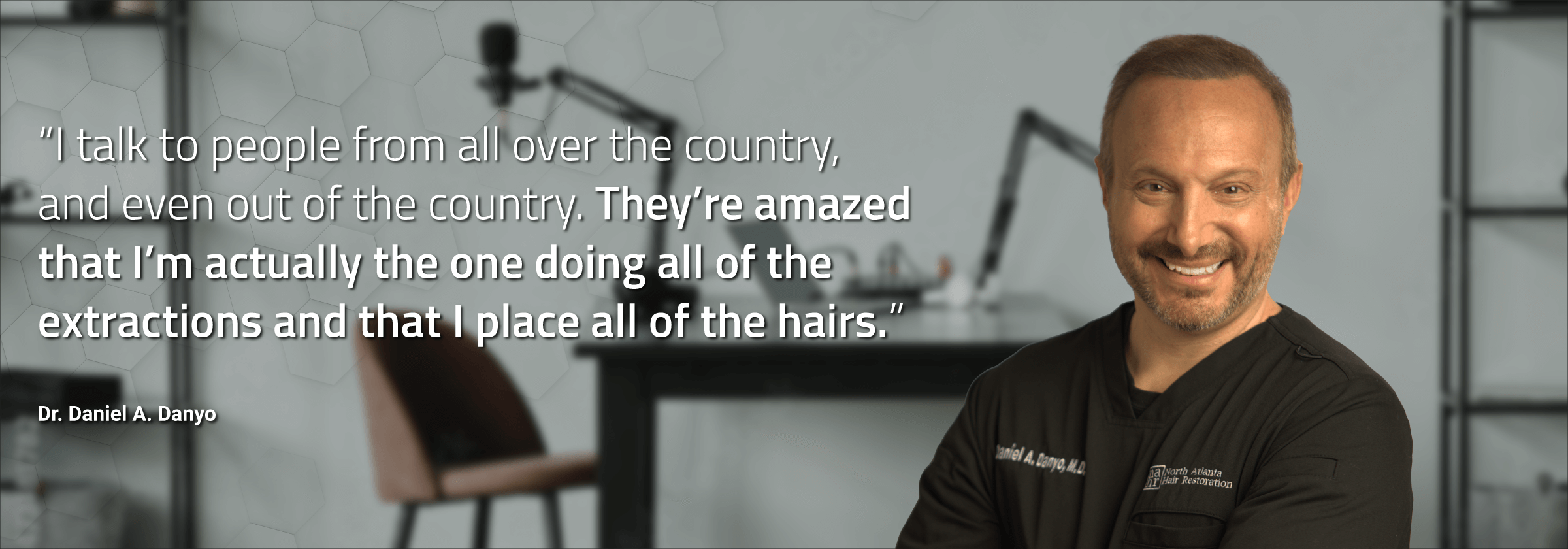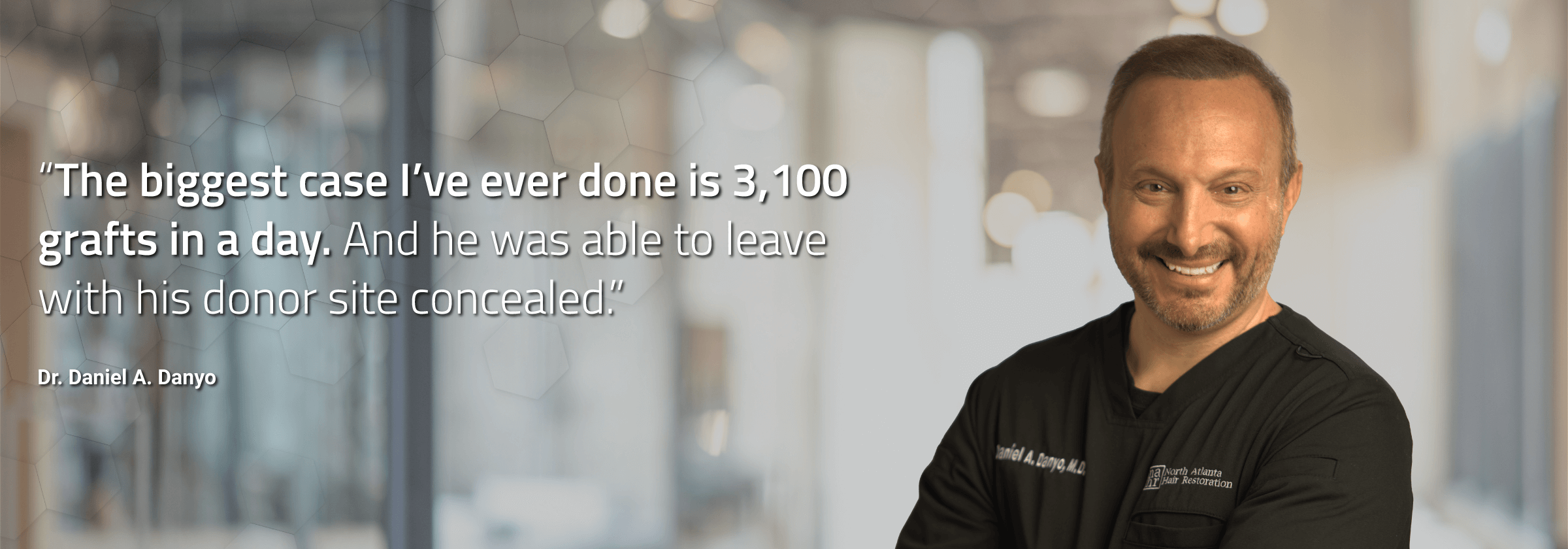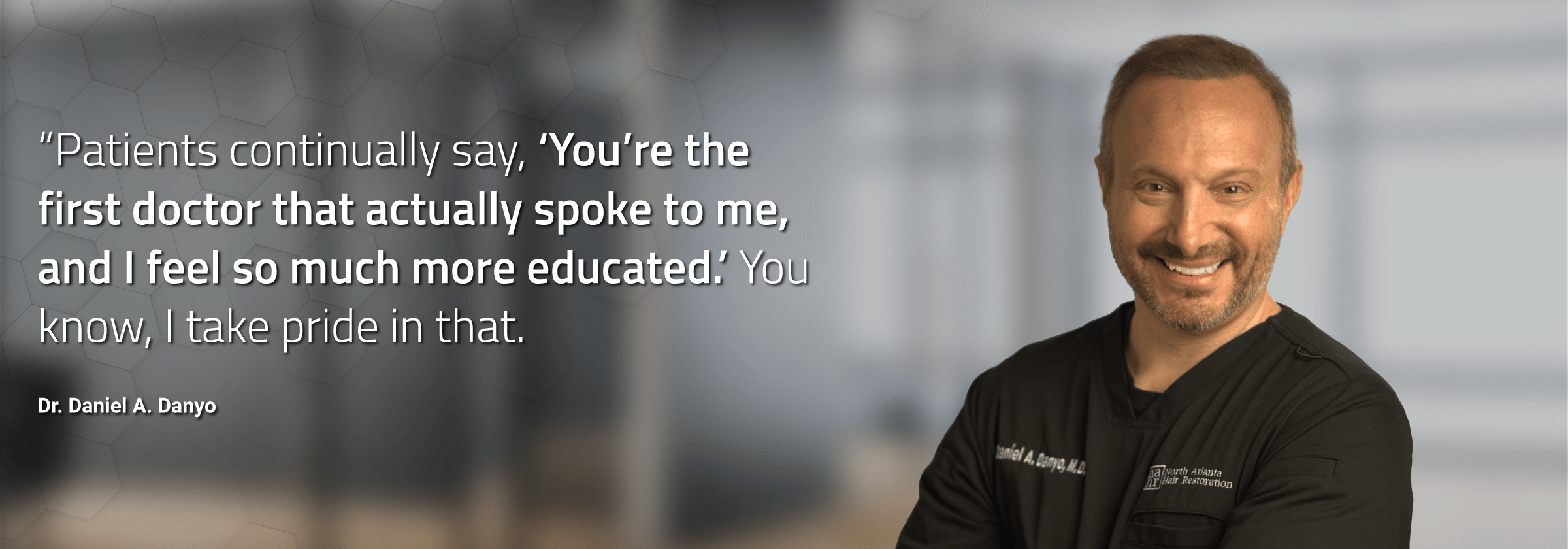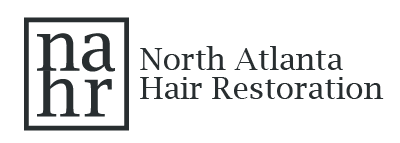The following is a transcript of Episode 3 of the Hair Restoration With Dr. Daniel A. Danyo podcast.
All episodes of the podcast can be found at Apple Podcasts, Google Podcast, and Spotify.
Dr. Danyo: I talk to people and…you know, I talk to people from all over the country, and even out of the country, and it’s almost a norm that doctors are not involved, and obviously it takes a team. But they’re amazed that I’m actually the one doing all of the extractions and that I place all of the hairs, and that’s a very rare situation in hair restoration.
Clark: That was the voice of Daniel A. Danyo, MD, founder and physician at North Atlanta Hair Restoration, a boutique medical practice solely dedicated to the diagnosis and treatment of male and female hair loss. You’re listening to Hair Restoration with Dr. Daniel A. Danyo. I’m your host, Clark Buckner, and all season long we’ll be speaking with Dr. Danyo about he and his team had North Atlanta Hair Restoration for helping his patients transform their everyday lives for the better. In this episode we’ll explore the biggest factors that set Dr. Danyo’s practice apart from typical hair restoration clinics. As a licensed physician personally involved in every case, Dr. Danyo lays out the steps he takes to educate his patients to perform safe and efficient procedures, and to give patients unparalleled results without interrupting their lives. Now, let’s jump in.
Dr. Danyo, how are you?
Dr. Danyo: I’m doing great Clark. How are you?
Clark: I’m doing fantastic. I am looking forward to another session with you. And what’s really fun about these is it gives me a chance and our listeners a chance just to get to know you more and to hear close up what are the things people are asking you the most, what’s on their mind, what you enjoy about this? Some of our other episodes we’ve dug into some specific activities of what you do. And I really want today to be about what differentiates, what separates you all from other practices. And this gives us a chance to maybe really dig into some of the aspects that you love, and you might not get the chance to talk to you on a regular basis. So I would just love to kind of start us off zoomed out about what you do, but really why it’s different than what we might be seeing elsewhere?

Dr. Danyo: Yeah, sounds great. Well, I think in general, there are three things that that separate my practice from others. But before I get into that, I’ll just say that I know for individuals that are thinking about either, you know, medical treatments for hair restoration or surgical, you know, i.e., hair transplant. When you go online, it literally is like the Wild Wild West because you got, you know, different types of hair transplant, different types of PRP. People do it, you know, all different ways. So I think what I lend to my patients initially what…you know, when I do a consultation is to just educate. And I found that there are three main areas that people are really focused on.
Clark: Yeah, start with the…so when you’re educating someone…and this is someone who has maybe been seeing some of that language online and the Wild Wild West. So they’re coming out of the Wild Wild West, and they get to you, and that’s where we’re at right now.
Dr. Danyo: Sure. Well, I mean, the first part is, you know, they go online and they’ll actually see, like, warnings on there. You know, warnings about hair transplant or warnings about PRP. And then as they delve into it, they’ll figure out that there are major warnings about clinics that actually are doing it with non-licensed clinicians and technician and there’s…
Clark: That’s in the U.S.?
Dr. Danyo: That’s in the U.S. And in minimal physician support. It’s such a problem that even our society, International Society of Hair Restoration Surgery, has a taskforce devoted to this. So, you know, they’re online, they’re confused. And really the biggest thing they have is, “If I get hair transplant on, is it going to be safe?” And the question is, “In my hands, absolutely.” So, what makes what I do kind of safer, you know, than other offices, for one, I’m totally involved from start to finish. So when somebody comes in from a consultation, I’ve looked at their medical record, I’ve looked at, you know, if any contraindications to — and we’ll focus on hair transplant — to hair transplant, I’ll look at, you know, even medical options to help facilitate the hair transplant. So everyone’s kind of dialed in. So getting kind of a safe foundation going into the procedure is key. And unfortunately, a lot of places have a sales guy who’s a non-physician, and not in the medical business at all, but is there, you know, getting a commission, you know, to get as many graphs as possible. And that’s a tough foundation to start a medical procedure.
Clark: You know, when you say people are seeing warnings, that’s primarily, you’re saying, because so many people out there are…unfortunately, they’re not licensed. They’re gonna have what their supposed to have?
Dr. Danyo: Exactly, yes. Or they can, you know, just look at, you know, comments at different practices. And, you know, some of the practices have terrible reviews, but, you know, they do such good marketing that they kind of enchant people to come into their practice. So, you know, the first step is really kind of making sense of what the needs are. And then whatever you do, surgically or medically, it’s all done in a very safe and medically supervised manner. And that means that I’m totally involved in the case, unlike, you know, many other clinics that there may be a reputable physician or surgeon in the office, but they’re not actually in the case.
Clark: What’s the difference between in the office and in the case? In your own words, your own perspective.
Dr. Danyo: Okay. Sure. Well, let’s say you have a plastic surgeon that is also doing breast augmentations. Maybe seeing patients in the office, you know, doing other cosmetic work. They buy a hair transplant machine and then pull in technicians to operate the machine, which means that the technician is grafting, and oftentimes, you know, placing all of the grafts while the doctor is in the office, but they’re not involved in the actual case.
Clark: There actually…there’s a machine just working on its own?
Dr. Danyo: Well, it could be, you know, the robot, you know, artist robot or it could be, you know, any number of FUE machines out there. And I would say, you know, companies like NeoGraft and SmartGraft, I mean, they definitely, you know, kind of tailor to practices that had technicians come in and do the majority of the case.
Clark: And we’ve talked before on here that your hands are on this from start to finish and your hands are…you are the person, you are providing them this procedure by not an autopilot machine.
Dr. Danyo: Yes, you know, and the crazy thing is that when I talk to people, and you know, I talk to people from all over the country, and even out of the country, and it’s almost a norm that doctors are not involved, and obviously it takes a team. But they’re amazed that I’m actually the one doing all of the extractions and that I place all of the hairs, and that’s a very rare situation in hair restoration. What the ISHRS, you know, International Society of Hair Restoration Surgery, recommends is that…well, first of all, they acknowledge that it’s definitely a team event, that it takes help, you know, to get this done. And I have two very experienced technicians that help me on every case. But the surgeons, especially with follicular unit extraction or FUE, need to be doing all of the extractions, and they either need to make surgical incisions so that the grafts can be hand-placed by technicians, or they need to place them with implanter pens, which we use.
Clark: Well, that’s a lot of considering, a lot of things to be thinking about. So that might be a good segue to our next item on our list. Let’s jump in to what that is.
Dr. Danyo: Yeah, well, the next item is concealment.
Clark: You were just describing a lot of things going on. And certainly, being able to conceal this, that’s one of the most common questions you’re hearing about.
Dr. Danyo: Yes. So, you know, I think because of kind of social norms and perceptions of hair transplant in the past with plugs, the majority of people do not want anyone to know that they’ve had this procedure done now, particularly as it relates to hair transplantation. So with FUE most clinics will at least shave the back of the head, if not the entire head. And obviously, if you have longer hair, especially if you’re a woman, you know, shaving part or all of your head is just a no go, you know, to have the procedure done, or, you know, people are having to take two weeks off from work and just kind of be in isolation until their hair grows back in. And from my standpoint, that’s unacceptable.
Clark: No, yeah. That’s such a big ask. If you’re trying to conceal something and you’re shaving a part of your hair off, the back of your head.

Dr. Danyo: Yeah. And because the hair has to be short to actually graft the hair. Obviously, when it’s all shaved, you can see all the hairs nits. It’s an easy procedure, you know, for the person actually doing the extraction. So we specialize in shaveless FUE procedure. And I’ve had people have… The biggest case I’ve ever done is 3,100 shaveless in a day. And he was able to leave with his donor site concealed. Now he had, like, major, major density back there. But the majority of our folks that get that have, you know, no portion of their donor site shaved, and then when they leave, the back of their head looks normal, or close to it.
Clark: And I’m just saying, I mean, that is very short turnaround.
Dr. Danyo: Yes. And we do it 80% of the time, it’s really what we’re known for. And it’s not a big deal for us. It’s a little bit more of a price getting the extra work. But you know, some places offer and they call it a non-shaving or non-shaving approach, but double the price and they make a big deal about it. This is our norm. So we’re extremely fast at it, efficient. We get just as good of a graft, whether it’s shaved or shaveless. And then, you know, we can go up top. And because of the typical size of our grafts being less than a millimeter, we use implanter pens. I don’t use a lot of extra fluid to lift the skin off the scalp, I don’t get a lot of bleeding, I get really good pain control. So all of these things kind of come in to where postoperatively the healing is fast, with minimal pain, minimal swelling in the face. And we have kind of a graft-care, you know, protocol after the procedure. So, you know, everything’s clean and not a lot of scabbing and nourished invoice [SP]. So people get back into the simulation very fast.
Clark: Fantastic. And you said there was three items earlier, right? Do you want to start rattling in at that…you know, what’s that final item [SP]?
Dr. Danyo: Yeah. Well, the final is results. So the results, you know, are key, but all of the other stuff plays into actually getting the procedure. But if they get the procedure, they want the best results. So I feel, you know, after all the cases I’ve done and I’ve done well over a million grafts myself, extraction in place.
Clark: Whoa.
Dr. Danyo: Yeah. And different types of hair and skin ties, we’ve done body and beard care. I’ve been in, you know, pretty long, you know, stressful cases. But all of that, you know, I learned every case in refining everything. So our model is to get perfect grafts. So that’s the first step. There’s immediately stored in a special transplants solution to where the hairs can stay there for even up to four or five days. So they’re totally happy in the medium. And then we get the grafts out and then they go from that medium into the implanter pen and then placed, it’s a direct stick and place. So, you know, that gives the least amount of contact to the air where the grafts can get dried out, and gives the grafts the best chance of surviving, even though the survival rate should be well above 90%, but actually growing quickly. When I see people at 6 months, I mean, they generally have 60%, 80%, even 90% growth. And in a lot of places, it’s 12 to 15 months. And I think a lot of it is how traumatized the grafts were or how much drying, how much manipulation was completed. So that kind of lends into all the results.
Clark: So do you think when you first meet with someone, the questions that they’re thinking about, do they know what they’re ultimately…what results and what success does look like, or is it more…is it simpler than that, more complicated?
Dr. Danyo: Well, I mean, you know, people have to look at before and after pictures and kind of look at, like, if we recommend 2,000 grafts, “These are 2,000 grafts individuals with kind of a similar hair line, and you know, ethnicity and head design.” And then, you know, they can make a reasonable assessment. But again, the results can vary depending on how thick each hair is, you know, if you have really thin hair versus very coarse hair, you know, you may require more grafts. But, you know, everyone’s results are individualized. And you know, we make it happen. If somebody is not at that really satisfied level, we generally will help them out either doing some platelet-rich plasma injection therapy, or even adding some grafts at no extra charge, either to refine the hairline or make it better.
Clark: Right. And I know you’ve been doing this a long time, you said you have over one million of these individual grafts. Am I using the right language with that? Yes. And through all the time you’ve been doing this, and when you communicate these three core things that someone is most interested in, are you surprised by anything to this day when you’re first meeting with someone or someone’s been on the fence about this? We know how intimate this is. We know how important this. In previous podcasts we’ve done together, you’ve talked about how their whole life can change from the confidence they feel, how it impacts them at work, at home, everywhere, but does anything surprise you from all this?

Dr. Danyo: I think the biggest thing is that…I get the sense that most of my patients who have seen other consults and many of them have seen five, six, seven consults, even more. I’m talking different offices. And they research it for years. I just find that they can, you know, continually say, “You’re the first doctor that actually spoke to me, and I feel so much more educated.” You know, I take pride in that. I love meeting with people and in educating. And if they’re not educated, then it’s not gonna work out. You’ve really got to educate and then figure out what their needs are, and then present it in a way that’s not salesy, and in a way that’s caring.
It’s something that…you know, I think a lot of that I learned from my father who is a physician, I spent a lot of time with him. That’s how he was. And that’s how I’ve modeled my practice. And I feel like, you know, my patients, they tell me that, “You’re a different type of doctor.” But you know, it’s something that comes from the heart. You know, I feel like people understand that. And the good thing is that I’m busy enough. I don’t need to sell anybody anything. I can provide a great service. And if people are interested in doing it, I’m happy to help. If they have more questions down the line, I’m happy to help. And when they’re ready to make the decision, I’m happy to implement it. So that that’s the attitude that I think needs to be pervade.
Clark: Well, Dr. Danyo, I appreciate you sharing more with us on this. I know this is a deep passion that you have, and clearly you show that from start to finish, hands on this entire process. And I’m looking forward to more conversations in the future.
Dr. Danyo: Yeah, sounds great. Always love them.
Clark: Thanks for listening to “Hair Restoration” with Dr. Daniel A. Danyo. You can book your consultation today with Dr. Danyo by simply calling (678) 845-7521 or online at nahairrestoration.com. And be sure to subscribe, rate, and review this podcast wherever you listen to your audio content.

